You can grow huge amounts of vegetables in a small space if you choose your varieties carefully. We asked Susanne Earl, the experienced gardener behind YouTube channel, That’s What We Call The Goodlife, for her advice on growing vegetables on a balcony or in a tiny garden. Here, she shares the two ‘superpowers’ to harness for successful small space growing…
Browse our patio gardening veg seeds for more inspiration.
Grow vertically: the best climbing veg to choose

Make the most of a sunny spot on the patio to grow cherry tomatoes
Image: Garden Gear Self-Watering Tomato Tower from Suttons
If you don’t have much space, growing vertically has to be your first superpower. If you choose the right vegetables, you’ll get bountiful amounts of edible goodies throughout the year. Even though I have a larger garden now, I still like to make the most of every inch of space so that the things I grow will see me through the winter months as well. (I freeze and preserve lots of my harvests.)
- Tomatoes: Tomatoes are one of the obvious choices, as they grow vertically by nature and do well in both the ground and in pots. If you grow them in pots, bear in mind that they’ll need more water and more liquid feed. Smaller cherry tomato varieties are easier to grow in a small space than the large steak tomatoes. That being said, you can still grow beefsteaks – simply put them in a bigger pot and give them lots of water when the fruits are swelling out. Tomatoes need to be supported. I tend to cane the tomatoes that I grow in the ground, but I train the ones in my greenhouse up string which is suspended from above.
- French climbing beans and runner beans: These vertical vegetables can also be planted in a pot or the ground. Support them with a teepee of canes, or grow them against trellis. I’ve seen some ingenious upcycling bean supports over the years, so feel free to improvise. I recommend sowing some bean seeds early in the year, and adding a few more a month or two later to ensure a continuous harvest. Keep them well fed with a liquid feed (especially the French beans) so they can continue growing well for some months. If I’m honest, I favour French beans over runner beans, but do make sure you buy the climbing variety rather than bush, and try some of the interesting colours like yellow and purple.
- Cucumbers: Perfect for vertical growing, I particularly like lunch box varieties as they’re easy to grow without worrying about removing male flowers. Varieties like ‘Nimrod’ F1, ‘Mini Stars’ F1 and F1 ‘Baby’ are some of my favourites and produce continuous amounts of mini cucumbers throughout the season. With no greenhouse required, they can be grown outside up canes or trellis.
- Peas: Another fantastic vertical grower, they do best on trellis or pea netting, although I have often hashed together my own frame using thin canes, tree branches and a ball of string! You can eat both the peas and the leaves in stir fries or salads. Mangetout varieties are very quick-growing as there’s no need to wait for the pods to fill out.
- Courgettes: If growing courgettes, go for one of the climbing varieties rather than a regular type. Bear in mind that they do get quite big.
Choose productive plants: the best cut-and-come-again veg

Harvest single leaves of kale as required
Image: Kale ‘Cobra’ F1 Seeds from Suttons
To maximise the productivity of a small space, your second superpower is growing cut-and-come-again veg. By this, I mean the vegetables that give you many harvests from a single plant. Here are some of my favourites:
- Salad bowl lettuce leaves – cut a few and more grow!
- Perpetual spinach – for a continuous supply of leaves.
- Chard – especially those that have beautiful colours like ‘Bright Lights’ or ‘Rainbow’ chard.
- Kale – which continues to grow through autumn and winter.
- Herbs – many produce harvests over and over. My personal favourites are mint, parsley, bay, chives, rosemary and sage.
Make use of every inch of space

Fill empty patio containers with cut-and-come-again salad leaves
Image: ‘Cos Lettuce Mix’ seeds from Suttons
Don’t underestimate what you can grow in a small amount of outside space. You can raise more produce and grow more flowers than you might think. I started off with a postage stamp courtyard garden in my first terraced house but, over the years, it overflowed with vegetables, fruit and flowers. I also remember my days of travelling to London by train and passing blocks of flats with balconies filled with various squashes and other curcubits scrambling precariously over trellis panels. And it wasn’t just one balcony. I was inspired by how many of these urban flats used their outside space to grow an abundance of colourful vegetables.
And let’s not forget edible flowers. Whilst I am far from an expert on the subject of edible flowers, nasturtiums make a fabulous addition to salads or an indulgent decoration. They’re incredibly simple to grow and ramble easily up trellis or pea netting or just pour over a pot. In my old courtyard garden, nasturtiums grew up the walls and over the edges, creating a beautiful explosion of colour and taste.
Small space gardening is a great way for beginners to learn. Don’t be over-concerned about making mistakes – everything is a good learning opportunity and even the most experienced gardeners don’t succeed all the time. Enjoy the journey and your first few platefuls of homegrown food. Good luck!
First image: Garden Gear – Metal Raised Garden Bed from Suttons
Last Updated on October 27, 2025 by Suttons Horticultural Team




